外刊经贸知识选读课文(1)
- 格式:doc
- 大小:96.00 KB
- 文档页数:7
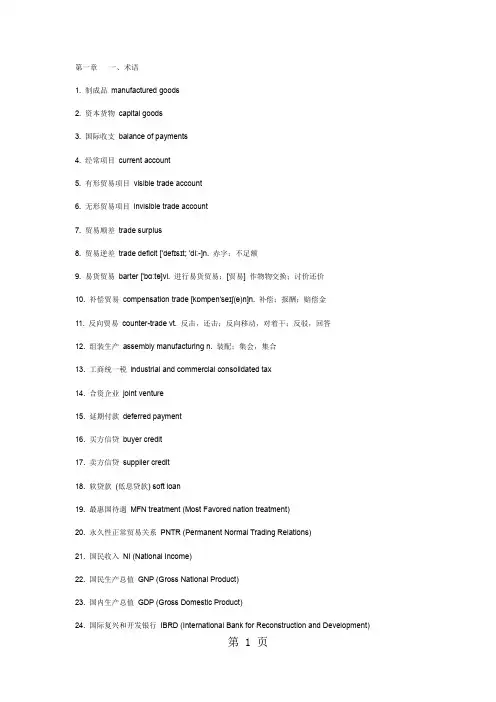
第一章一、术语1. 制成品manufactured goods2. 资本货物capital goods3. 国际收支balance of payments4. 经常项目current account5. 有形贸易项目visible trade account6. 无形贸易项目invisible trade account7. 贸易顺差trade surplus8. 贸易逆差trade deficit ['defɪsɪt; 'diː-]n. 赤字;不足额9. 易货贸易barter ['bɑːtə]vi. 进行易货贸易;[贸易] 作物物交换;讨价还价10. 补偿贸易compensation trade [kɒmpen'seɪʃ(ə)n]n. 补偿;报酬;赔偿金11. 反向贸易counter-trade vt. 反击,还击;反向移动,对着干;反驳,回答12. 组装生产assembly manufacturing n. 装配;集会,集合13. 工商统一税industrial and commercial consolidated tax14. 合资企业joint venture15. 延期付款deferred payment16. 买方信贷buyer credit17. 卖方信贷supplier credit18. 软贷款(低息贷款) soft loan19. 最惠国待遇MFN treatment (Most Favored nation treatment)20. 永久性正常贸易关系PNTR (Permanent Normal Trading Relations)21. 国民收入NI (National Income)22. 国民生产总值GNP (Gross National Product)23. 国内生产总值GDP (Gross Domestic Product)24. 国际复兴和开发银行IBRD (International Bank for Reconstruction and Development)25. 国际开发协会IDA (International Development Association)26. 国际金融公司IFC (International Finance Corporation)27. 经济合作和发展组织OECD (Organization for Economic Cooperation and Development)28. 国际清算银行BIS (Bank for International Settlement)29. 欧洲经济共同体EEC (European Economic Community)30. 欧洲联盟EU (European Union)31. 外商直接投资FDI (Foreign Direct Investment)二、词语释义:1. substantially: dramatically; significantly; considerably大幅度戏剧地;/引人注目地,意味深长地;/值得注目地; /相当地,非常地;2. subsequently: afterwards随后,其后;后来/后来;然后3. exacerbate: deteriorate; worsen; aggravate; make worse使加剧;使恶化;激怒/恶化,变坏/恶化;变得更坏;更坏/加重;使恶化;激怒/使更糟4. withdraw: cancellation撤退;收回;撤消;拉开/取消;删除5. theme: principle6. in return for: in exchange for7. disrupt: interrupt 中断8. destined: designed 注定的,有计划的9. pronounced: marked 显著的;断然的;/显著的;有记号的10. in the wake of: following; after with11. undue: too much; unbearable12. reverse: change to the opposite13. buoyant: brisk14. outcome: result15. boost: stimulate; promote; develop16. recover: rebound17. facilitate: make easy18. run-down: reduction19. mount exhibitions: hold exhibitions20. insofar as: to the extent21. bottlenecks: obstacles三、句子翻译1. During the 1950s China exported agricultural products to the USSR and East European countries in return for manufactured goods and the capital equipment required for the country‘s industrialization program which placed emphasis on the development of heavy industry.20世纪50年代,中国向前苏联和东欧各国出口农产品以换取制成品和国家的工业化计划所要求的资本设备,而国家的工业化计划则强调重工业的发展。
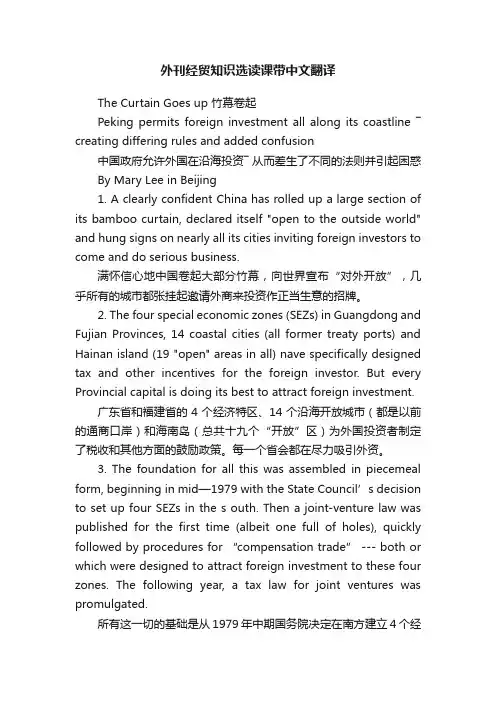
外刊经贸知识选读课带中文翻译The Curtain Goes up 竹幕卷起Peking permits foreign investment all along its coastline ― creating differing rules and added confusion中国政府允许外国在沿海投资― 从而差生了不同的法则并引起困惑By Mary Lee in Beijing1. A clearly confident China has rolled up a large section of its bamboo curtain, declared itself "open to the outside world" and hung signs on nearly all its cities inviting foreign investors to come and do serious business.满怀信心地中国卷起大部分竹幕,向世界宣布“对外开放”,几乎所有的城市都张挂起邀请外商来投资作正当生意的招牌。
2. The four special economic zones (SEZs) in Guangdong and Fujian Provinces, 14 coastal cities (all former treaty ports) and Hainan island (19 "open" areas in all) nave specifically designed tax and other incentives for the foreign investor. But every Provincial capital is doing its best to attract foreign investment.广东省和福建省的4个经济特区、14个沿海开放城市(都是以前的通商口岸)和海南岛(总共十九个“开放”区)为外国投资者制定了税收和其他方面的鼓励政策。
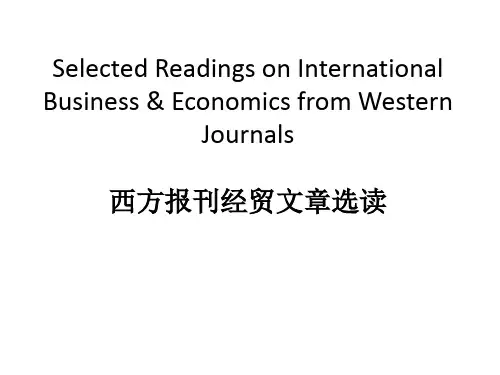
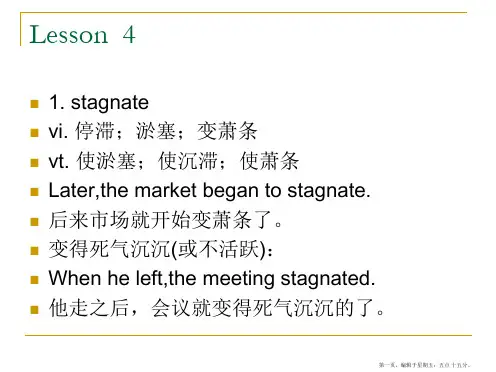
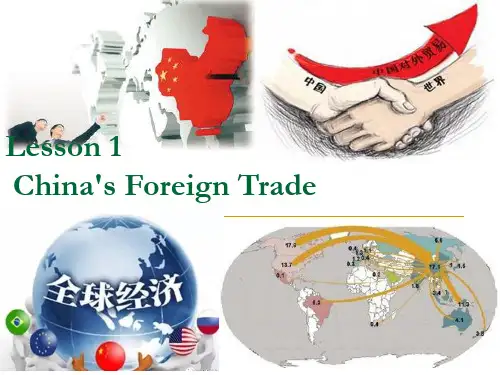

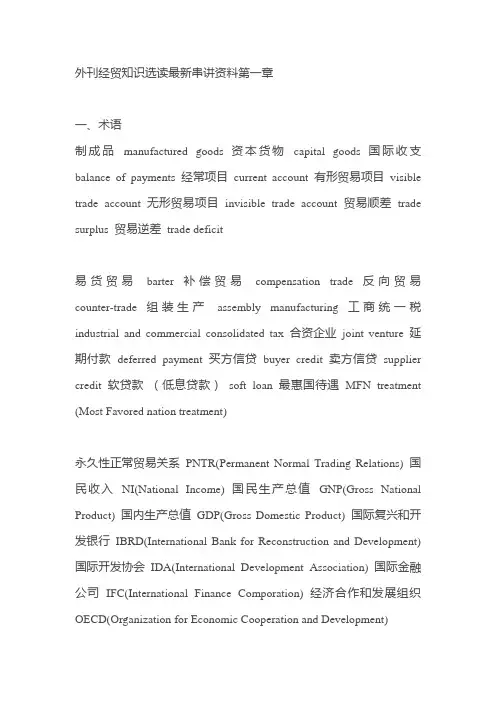
外刊经贸知识选读最新串讲资料第一章一、术语制成品manufactured goods 资本货物capital goods 国际收支balance of payments 经常项目current account 有形贸易项目visible trade account 无形贸易项目invisible trade account 贸易顺差trade surplus 贸易逆差trade deficit易货贸易barter 补偿贸易compensation trade 反向贸易counter-trade 组装生产assembly manufacturing 工商统一税industrial and commercial consolidated tax 合资企业joint venture 延期付款deferred payment 买方信贷buyer credit 卖方信贷supplier credit 软贷款(低息贷款)soft loan 最惠国待遇MFN treatment (Most Favored nation treatment)永久性正常贸易关系PNTR(Permanent Normal Trading Relations) 国民收入NI(National Income) 国民生产总值GNP(Gross National Product) 国内生产总值GDP(Gross Domestic Product) 国际复兴和开发银行IBRD(International Bank for Reconstruction and Development) 国际开发协会IDA(International Development Association) 国际金融公司IFC(International Finance Comporation) 经济合作和发展组织OECD(Organization for Economic Cooperation and Development)国际清算银行BIS(Bank for International Settlement) 欧洲经济共同体EEC(European Economic Community) 欧洲联盟EU(European Union) 外商直接投资FDI(Foreign Direct Investment)1.The special Economic Zone 经济特区2.a well-placed source 一位高层消息灵通人士3.infrastructure 基础设施4.capital stock 实际资本5.consumer goods 消费品6.preferential tax rate 优惠税率7.cooperative enterprise 合作(经营)企业8.ETDZ ( Economic &Technical Development Zone )经济技术开发区9.entrepreneurship 企业家精神10.means of production 生产资料11.stock-taking 评估12.Allocation of resources 资源配置13.macroregulation and control 宏观调控14.fiscal policies 财政政策15.tight monetary policy 紧缩的货币政策16.working capital 运营资本17.basic policy 基本国策18.technical transformation 技术革新一、术语:1.economic heavyweight 举足轻重的经济强国mercial hub 商业活动中心3.Per capita 人均4.Gross National Product 国民生产总值5.punitive import tariff 惩罚性进口关税6.securities 有价证券7.real estate market 房地产市场8.“ Greater China”trade bloc “大中华”贸易集团9.conglomerate 跨行业公司10.consortium 国际财团11.GATT:General Agreement on Tariffs and Trade 关贸总协定1.centrally-planned economy 中央计划经济2.market economy 市场经济3.disinflationary (anti-inflationary) policies 反通货膨胀政策4.deflation 通货紧缩5.short-term dollar interest rates 短期美元利率modity market 商品市场7.nominal (dollar) terms 名义(美元)价8.constant (dollar) terms 不变(美元)价9.business cycle 商业周期10.weighted average 加权平均数11.hard currencies 硬通货12.fiscal adjustment 财政调整13.portfolio investment 有价证券投资14.market diversification 市场多元化15.tight credit policy 紧缩的信贷政策16.exchange-rate devaluation 汇率贬值17.accommodative monetary policy 融通性货币政策18.yield curve 收益曲线19.per capita GDP 人均国内生产总值20.GATT: General Agreement on Tariffs and Trade 关贸总协定21.EMS: European Monetary System 欧洲货币体系22.GDP deflator 消除国内生产总值通货膨胀因素指数( GDP 平减指数)23.CMEA (Comecon): Council for Mutual Economic Assistance 经互会24.LIBOR: London Inter-Bank Offered Rate 伦敦同业银行优惠利率22.per capita income 人均收入23.multilateral trade agreements 多边贸易协定24.Portfolio investment 证券投资25.cyclical deceleration in investment spending 生产总值通货膨胀因素指数26.the population-weighted growth rate 人口加权增长率trade representative 贸易谈判代表government procurement 政府采购NAFTA ( North America Free Trade Agreements )北美自由贸易协定trade sanctions 贸易制裁trade hawks 贸易中主张强硬路线的鹰派人物一、术语:the single market 统一大市场 Maastricht Treaty 马斯特里赫特条约barrier-free market 无壁垒市场 free-trade zone 自由贸易区referendum 公民复决投票 merger 兼并budget cuts 预算削减 political and economic integration 政治经济一体化deregulation 放松管制 privatization 私有化二、词语释义:substantially : dramatically, significantly, considerably subsequently: afterwardsexacerbate: deteriorate, worsen; aggravate; make worsewithdraw: cancellationtheme: principlein return for: in exchange fordisrupt: interruptdestined: designedpronounced: markedin the wake of: following; after withundue: too much; unbearablereverse: change to the oppositebuoyant: briskoutcome: resultboost: stimulate; promote; developrecover: reboundfacilitate: make easyrun-down: reductionmount exhibitions: hold exhibitionsinsofar as: to the extentbottlenecks: obstacles二、词语释义:1.in piecemeal form: piece by piece; gradually 逐渐的2.showpiece: a prime or outstanding example 典范3.pipedream: fantasy; daydream; dream that cannot be realized 白日梦4.from scratch: from the very beginning 从零开始,从最初开始5.grassroots: basic level 基层6.the dust settles: the confusion ends 尘埃落定7.in the driver’s seat: in the dominant position二、词语释义:1.jockey: move2.is bustling with: is filled with3.giddy: dizzy; euphoric4.farfetched: improbable; incredible5.clear: earn a net profit6.deal a hard blow t strike heavily7.rung: level8.retaliation: return of ill treatment for ill treatment; revenge; reprisal9.career out of control: run out of control二、词语释义:1.in a row: in succession2.easing: slowing down; decrease3.momentum: force of movement4.underlying: being at the basis of5.slackening: slowing of speedpound: worsen7.moderate inflation: ease inflation8.robust: strong and healthy9.setbacks: frustrations10.slump: depression11.edge down: move slowly down12.depreciation: devaluation13.spike: abrupt increase14.pick-up: recovery15.rein in: control16.bottoming-out: reaching the lowest point before rising again (止跌回升)17.stagnat: stop; almost二、词语释义:1.tough: uncompromising (不妥协的,强硬的)2.discrimination: unfair treatment3.sanctions: penalty4.escalate: develop; intensify5.frictions: conflicts6.procurement: purchase7.be bullied into doing: be forced to do8.is awake t is conscious of9.amenable to responsive to10.a ragged start: a poor start11.intolerable: unbearable12.retaliate: revenge; reprisal13.impose: exert; influence14s.drawn-out: prolonged and boring15.shock: impact16. prompting: provoking17. tactical: skillful18. underpinning: foundation19. peeved: annoyed20. embrace: acceptance二、词语释义:big bang: strong and powerful effect; impact (不同凡响的效果)sour: worsen backlash: a strong adverse reactionbe bursting to: be eager to (迫不及待地… ) skid: slide; fall gush about: talk about with excessive enthusiasm (滔滔不绝地谈论)translate into: transform into hang over: impend over; threaten 三、句子翻译1.During the 1950s China exported agricultural products to the USSR and East European countries in return for manufactured goods and the capital equipment required for the country’s industrializatio n programme which placed emphasis on the development of heavy industry.20世纪50年代,中国向前苏联和东欧各国出口农产品以换取制成品和国家的工业化计划所要求的资本设备,而国家的工业化计划则强调重工业的发展。
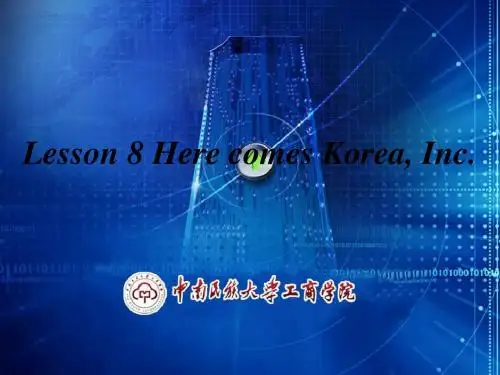
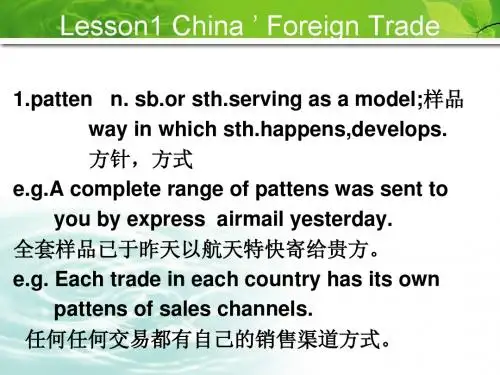
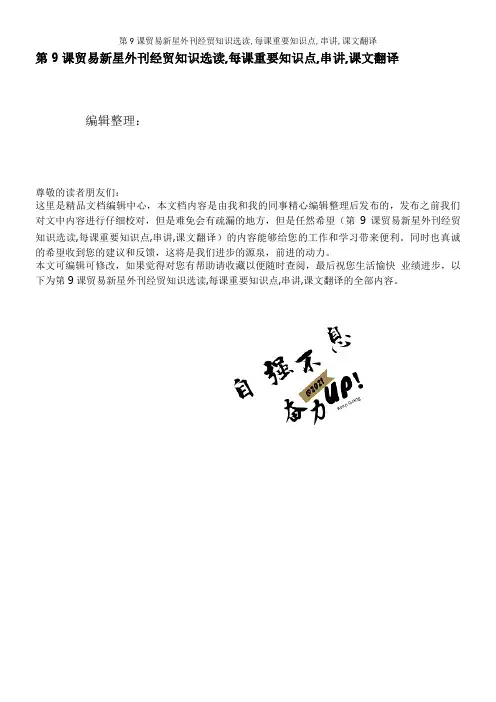
第9课贸易新星外刊经贸知识选读,每课重要知识点,串讲,课文翻译编辑整理:尊敬的读者朋友们:这里是精品文档编辑中心,本文档内容是由我和我的同事精心编辑整理后发布的,发布之前我们对文中内容进行仔细校对,但是难免会有疏漏的地方,但是任然希望(第9课贸易新星外刊经贸知识选读,每课重要知识点,串讲,课文翻译)的内容能够给您的工作和学习带来便利。
同时也真诚的希望收到您的建议和反馈,这将是我们进步的源泉,前进的动力。
本文可编辑可修改,如果觉得对您有帮助请收藏以便随时查阅,最后祝您生活愉快业绩进步,以下为第9课贸易新星外刊经贸知识选读,每课重要知识点,串讲,课文翻译的全部内容。
第9课贸易新星Prosperity Persists in the UAE阿拉伯联合酋长国持续繁荣一、(Excerpts)(摘录)The profits of peace and prosperity 和平与共荣益处多多1。
In the two years since Iraq was ousted from Kuwait, peace and prosperity have returned to the Gulf region, and the UAE in particular .Major development plans have resumed in Abu Dhabi's oil and gas sector and Dubai’s trade figures are soaring as more companies adopt the emirate as their regional base。
Yet, below the surface calm, defense is still of great concern。
The topic dominated discussions at the GCC summit in Abu Dhabi in December,and in February the government announced its biggest—ever investment in defense equipment at IDEX 1993, an exhibition held in Abu Dhabi。
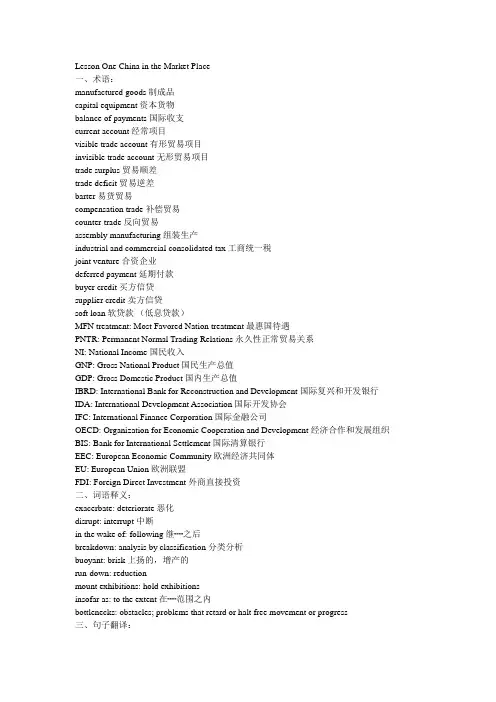
Lesson One China in the Market Place一、术语:manufactured goods 制成品capital equipment 资本货物balance of payments 国际收支current account 经常项目visible trade account 有形贸易项目invisible trade account 无形贸易项目trade surplus 贸易顺差trade deficit 贸易逆差barter 易货贸易compensation trade 补偿贸易counter-trade 反向贸易assembly manufacturing 组装生产industrial and commercial consolidated tax 工商统一税joint venture 合资企业deferred payment 延期付款buyer credit 买方信贷supplier credit 卖方信贷soft loan 软贷款(低息贷款)MFN treatment: Most Favored Nation treatment 最惠国待遇PNTR: Permanent Normal Trading Relations 永久性正常贸易关系NI: National Income 国民收入GNP: Gross National Product 国民生产总值GDP: Gross Domestic Product 国内生产总值IBRD: International Bank for Reconstruction and Development 国际复兴和开发银行IDA: International Development Association 国际开发协会IFC: International Finance Corporation 国际金融公司OECD: Organization for Economic Cooperation and Development 经济合作和发展组织BIS: Bank for International Settlement 国际清算银行EEC: European Economic Community 欧洲经济共同体EU: European Union 欧洲联盟FDI: Foreign Direct Investment 外商直接投资二、词语释义:exacerbate: deteriorate 恶化disrupt: interrupt 中断in the wake of: following 继┉之后breakdown: analysis by classification 分类分析buoyant: brisk 上扬的,增产的run-down: reductionmount exhibitions: hold exhibitionsinsofar as: to the extent 在┉范围之内bottlenecks: obstacles; problems that retard or halt free movement or progress三、句子翻译:Official recognition that foreign technology could play a major role in modernizing the Chinese ec onomy has caused imports to rise by more than 50 per cent in 1978, placing undue strain on the na tional economy.官方认为,外国技术可在中国经济现代化中起重要作用,这导致了1978年中国的进口增加了50%以上,从而给国民经济带来了重压。
第13课市场分析外刊经贸知识选读,每课重要知识点,串讲,课文翻译编辑整理:尊敬的读者朋友们:这里是精品文档编辑中心,本文档内容是由我和我的同事精心编辑整理后发布的,发布之前我们对文中内容进行仔细校对,但是难免会有疏漏的地方,但是任然希望(第13课市场分析外刊经贸知识选读,每课重要知识点,串讲,课文翻译)的内容能够给您的工作和学习带来便利。
同时也真诚的希望收到您的建议和反馈,这将是我们进步的源泉,前进的动力。
本文可编辑可修改,如果觉得对您有帮助请收藏以便随时查阅,最后祝您生活愉快业绩进步,以下为第13课市场分析外刊经贸知识选读,每课重要知识点,串讲,课文翻译的全部内容。
第13课市场分析Hong Kong is Tops at Cracking U。
S。
Shell Eggs香港是美国蛋类的大市场By Michael L.HumphreyWhile most people think of Hong Kong as a small market, it is, in fact, the largest export market for U.S.shell eggs。
In 1985, the United States exported over 7 million dozen shell eggs valued as $ 4 million for food use in Hong Kong.That market alone accounted for half of the volume and 40 per cent of the value of total U。
S。
exports of shell eggs for food use。
大多数人认为香港是一个小市场,可它实际上是美国蛋类的最大的出口市场。
1985年,美国向香港出口了7百多万打食用蛋类,价值4百万美元。
仅此市场就占据了美国食用蛋类出口量的一半,总价值的40%。
外刊经贸知识选读全真一英译汉1.the Special Drawing Right 特别提款权2.OPEC 石油输出国组织3.coastal cities 沿海城市4.trade sanctions 贸易制裁5.the state apparatus 国家机器ernment procurement 政府采购7.free-trade-zone 自由贸易区pensation trade 补偿贸易9.White Paper 白皮书10.consumer goods 日用消费品汉译英1.贸易谈判trade negotiation2.跨行业公司conglomerate3.不公平贸易unfair trade4.欧洲一体化European integration5.政府津贴state subsidy6.经济衰退economic recession7.招标invite tender8.撤销金融管制规定financial deregulation9.供应过剩glut of supplies10.金融危机financial crisis全真(二)英译汉1.state-run enterprises 国营企业2.trade fairs and exhibitions 贸易展销会3.primary production 初级产品4.European Community 欧洲共同体5.austerity program 紧缩计划6.risk-weighted assets 高风险资产7.market regulation 市场调查8.equivalent value 对等价值9.supermarket 超级市场10.protectionism 保护主义汉译英1.外汇收入foreign exchange income2.供求模式the pattern of supply and demand3.活期账户current account4.时髦词语buzzword5.股票市场stock market6.补偿贸易协定compensation trade agreement7.质量证书certificate of quality8.期货futures9.仓库交货Ex-warehouse10.拍卖auction全真(三)英译汉1.b arter 易货贸易2.cooperative enterprise 合作经营企业3.punitive import tariff 惩罚性进口关税4.consortium 国际财团5.hard currency 硬通货6.deinflationary policies 反通胀政策7.licenser 转让费8.market forces 市场力量9.exclusive contract 独家经销合同10.discount rate 贴现率汉译英1.非耐用商品soft commodity2.经济技术开发区ETDZ(Economic & Technical Development Zone)3.贸易顺差trade surpuls4.个人所得税personal income tax5.无偿还能力insolvency6.软饮料soft drink7.收盘价closing price8.现货市场spot market9.出口配额制export quota system10.快餐店fast food shops。
Lesson 1 China’s Foreign Trade(中国的对外贸易)重点词组:1、link 连接(这里为往来2、pattern 模式、结构*3、substantially 相当大的、重大的*4、in return for 作为…地交换5、manufactured goods 工业产品6、capital equipment 资本设备7、industrialization programme 工业项目8、heavy industry 重工业9、produced gains in 从… 中获利*10、economic imbalances 经济失衡11、national income 国民收入12、contract 收缩、下降13、aid 援助14、shift away form …towards 从…转移到…*15、consistent theme 一贯的主题16、strong emphasis placed on 强调、重视17、trade relating 贸易往来18、fell sharply 急剧下降(下滑)19、grown rapidly 迅速增长*20、sign in 签订21、in the wake of 在…之后22、normalization of diplomatic relations 外交关系正常化23、come into force 生效*24、most-favored nation treatment最惠国待遇25、accounted for 占……*26、category 种类*27、item 项目28、US dollar value of 以美元计算的29、increased at an average rate of 平均以……比率增长 *30、per annum 每年31、visible trade surplus 有形贸易余额32、rise sharply 迅速上升、猛增*33、play a major role 起重要作用*34、undue strain 沉重负担35、a net grain exporter 粮食净出口国*36、pattern 模式*37、reverse 逆转,相反38、jump 暴涨*39、visible trade account 有形贸易收支40、in deficit 赤字、逆差*41、buoyant 趋于上升*42、attribute to 归因于……43、re-reported 再出口*44、leading 最主要的*45、decline 下降、减少*46、supplier 供应者*47、industrial country 工业化国家48、expect 期望*49、boost 推动、提高*50、recovered strongly 很大恢复*51、introducing advanced technology of 向…引进先进技术*52、sophistication 精密、尖端53、invisible account 无形贸易收支54、balance of payments 国际收支55、earnings 收益、收入*56、current account 经常项目57、in surplus 处于顺差、有盈余*58、reserves 储备、储量*59、the balance 收支平衡*余额60、specializes in 专门从事*61、balance 平衡*62、earnings and requirements 收入和需求63、run-down 减少、缩减*64、as a means of 作为65、international economic co-operation 国际经济合作66、mount 举行、进行67、trade fairs 商品展销会68、practice 惯例69、compensation trade 补偿贸易70、raw materials 原材料71、in return 作为报答72、barter 易货贸易73、counter-trade 反向贸易74、a series of 一系列75、designed to 旨在76、joint venture 合资企业77、The China International Trust Investment Corporation(CITIC)中国国际信托投资公司78、transfer 转让*79、for the time being 目前、暂时80、direct investment 直接投资81、access 接近的机会、享用权*82、the international capital markets 国际资本市场83、commercial terms 商业条件84、compile 收集、汇集85、OECD 经济合作和发展组织86、Bank for International Settlements 国际清算银行87、bulk 绝大部分、主体88、in the short-term 从短期来看89、over the longer term 从长期来看90、representative offices 办事处三、课后问题:1、What’s the meaning of “the pattern of China’s foreign trade”?“The pattern of China’s foreign trade” refers c hiefly(主要的) to the commodity structure of China’s foreign trade and her trade partnership with the world.2、What kind of clause is introduced by “when” in the sentence of the third paragraph, section 1? An adverbial (状语) clause or an attributive (定语) one?An attributive clause3、“Official recognition that foreign technology could play a major role in modernizing the Chinese economy had caused imports to rise by more than 50 per cent in 1978 placing undue strain (过度负担)on the national economy.”(中国政府认识到,国外技术对本国经济现代化作用重大,这使1978年中国的进口额增长了50%以上,结果国民经济背上了沉重的负担。
Lesson 1China in the Market PlaceBarry Coulthurst examines the development of China’s trade policy and the present state of the overseas economic links --巴里库尔塞斯特对中国贸易政策的演变和当前与海外经济往来状况的研究The pattern of China’s foreign trade has changed substantially since the founding of the people’s Republic, During the 1950s China exported agricultural products to the USSR and East European countries in return for manufactured goods and the capital equipment required for the country’s industrialization programme which placed emphasis on the development of heavy industry. The Great Leap Forward of 1958-1959 initially produced gains in agricultural and industrial production, but subsequently resulted in serious economic imbalances. Economic problems were exacerbated by three bad harvests (1959-1961) with the result that national income and the volume of foreign trade contracted during 1960-1962 The withdrawal of Soviet economic and technical aid in the early-1960s caused trade to shift away from the USSR and its Comecon partner towards Japan and Western Europe. A consistent theme of China’s foreign trade policies has been the strong emphasis which has been placed on developing trade relations with the Third World countries.The growth of foreign trade was disrupted again during the cultural Revolution(1966-1976) when agricultural and industrial production fell sharply and transportation constraints became more serious.Foreign Trade, which has a major role in the four Modernizations programme, has grown rapidly over the past few years.A major trade agreement with Japan, under which China exports coal and oil in return for industrial equipment and technology was signed in February 1978. China also signed a long-term trade agreement with the EEC in 1978 while trade with the USA has increased rapidly in the wake of the normalization of diplomatic relations at the beginning of 1979. The Sino-USA agreement on trade relations, which came into force in February 1980. Accords China Most-favoured nation treatment.BreakdownA commodity breakdown of China’s trade shows that fuels accounted for 24 per cent of total exports in 1982, food products for 13 percent, textile fibres and mineral ores for 7 per cent and manufactured goods(the most important products were textiles, chemicals and machinery and transport equipment ) for 55 percent. Since the founding of the people’s republic strong emphasis has been placed on importing capital equipment in order to strengthen the industrial sector. But the leading categories of imports in 1982 were food, which accounted for 22 percent of total, light manufactured items with a share of 20 percent and machinery and transport equipment with 17 percent.During the past few years a major objective of the Chinese authorities has been to reduce the proportion of agricultural exports, while increasing that of industrial and mineral products. A wide variety of industrial goods are now exported and Chinese capital equipment has been used by a number of developing countries to establish projects in areas such as agriculture, forestry, light industry, food processing, water conservation and transport and communications.The Balance Shifts.The US dollar value of Chinese exports increased at an average rate of almost 18 percent per annum between 1978 and 1983, while imports increased by approximately 11 per cent pere annum. As a result, the visible trade surplus rose sharply from US$1.4 billion in 1981 to US$4.4 billion in 1982 AND us$3.7 billion in1983. Exports grew much faster than imports during this period not only because of the strong emphasis placed on exporting by China’s economic planners, but also because a number of industrial projects were postponed in 1979. Official recognition that foreign technology could play a major role in modernizing the Chinese economy had caused imports to rise by more than 50 percent in 1978 placing undue strain on the national economy. Grain imports have fallen sharply over the past few years- China became a net grain exporter in 1984 – and in 1983 the country started to export soyabeans and cotton.The pattern of foreign trade growth was reversed in 1984; the value of exports increased by 10 percent, but imports jumped 38 percent with the result that the visible trade account was in deficit by US$1.1 billion. The strong increase in importslast year is attributed to buoyant economic activity as well as to the success of the Government’s trade and foreign investme nt policies.Direction of TradeHongKong is China’s major export market accounting for approximately 26 percent of total exports in 1983(though much is re-exported to other destinations from there). Other important markets include Japan, with a share of 20 percent in 1983, and the USA with approximately 8 percent. The EEC’s share of China’s exports has generally been around 11-12 percent over the past few years (the leading export markets within the European Community are Germany and United Kingdom), while the proportion destined for the comecon countries declined from almost 15 percent in 1978 to 6 percent in 1983. The non-oil developing countries (excluding Hong Kong) accounted for 23 percent of China’s total exports in 1983.In sharp contrast the developing countries provided less than 15 percent of China’s imports in 1983. The most important suppliers among the industrial countries were Japan, with a share of 26 per cent, and the USA with 13 percent. The EEC’s share in 1983 was 15 percent and that of comecon 8.2 per cent.The successful outcome to negotiations between Britain and China about the future of Hong Kong will strengthen Sino-British relations and is expected to boost trade between the two countries. A large British economic and trade delegation, headed by Lord Young, Minister without portfolio, visited China in March. The value of Chinese exports to Britain, which rose rapidly between 1977 and 1980, declined in 1981-1982, but recovered strongly in 1983; imports from the United Kingdom followed a similar pattern. The most important Chinese exports to Britain in 1983 were clothing, textile fibres, tea and food products while the leading British exports included iron and steel, machinery and transport equipment, scientific instruments, chemicals and textile fibres.Chinese officials stress the importance of introducing advanced technology to domestic industry, but the need is for technology of varying degrees of sophistication, not necessarily for advanced technology as that term is understood in the West.Reserves RiseThere are no official statistics covering the invisible account of the balance of payments, but the size of the visible trade surplus during 1981-1983 and a pronounced increase in earnings from tourism suggest that the current account has been in surplus over the past few years.Foreign exchange reserves have risen rapidly from approximately US $2.5 billion at end-1980 to US$17.0 billion (sufficient for approximately eight months’ imports) by October 1984. Approximately US $12 billion of the country’s r eserves are held by the central bank, the people’s bank of China, while the balance is controlled by the bank of China which specializes in foreign exchange business. Individual cities must try to balance their foreign exchange earnings and requirements, but there is some scope for purchasing additional foreign exchange with Renminbi yuan. The authorities are willing to permit a run-down is the country’s international reserves over the next few years as a means of accelerating the introduction of foreign technology.China has shown a much more flexible approach to foreign trade over the past few years and has adopted a series of measures designed to strengthen international economic co-operation. Foreign countries are encouraged to mount exhibitions of their goods and China itself has participated in a number of trade fairs and exhibitions held abroad. Since the late 1970s China has also adopted foreign trade practices long-established in many other countries. Goods are produced according to a sample provided by customer, while strong encouragement is given to compensation trade whereby a foreign seller supplies raw materials and equipment and receives manufactured goods, produced by the equipment provided, in return. Compensation trade differs from barter or counter-trade insofar as there is a direct link between the equipment supplied from abroad and manufactured product. Assembly manufacturing began in 1978 and particular forms of foreign trade are eligible for exemption from customs duties and taxation.Investment EncouragedA series of polices designed to encourage foreign investment have accompanied these trade reforms. A lao adopted in1979 defines the principles governing the rights and interests of participants in joint ventures. The China International Trust and Investment Corporation(CITIC), established in 1979, co-ordinates incoming foreign investment, promotes joint ventures by assisting Chinese and foreign enterprises to find suitable business partners and also has responsibility for negotiating contracts relating to 100 percent foreign-owned enterprises When negotiations are complete and a joint venture contract has been agreed, it is submitted to the ministry of foreign Economic Relations and Trade for final approval.China’s cautious approach to f oreign borrowing is to be maintained, at least for the time being. The debt problems confronting a number of developing countries have reinforced China’s determination to introduce foreign technology by means of direct investment and concessionary finance rather than by raising substantial sums of money on the international capital markets. Foreign investments is advantageous insofar as it facilitates the transfer of technology and skills and avoids creating an overhang of debt. The authorities do not consider it appropriate to incur large amounts of external debt until a number of practical bottlenecks in the economy, such as an inadequate transport network and energy constraints, have been tackled. China’s access to substantial sums of money from the World bank also reduces the need to borrow on commercial terms.China has borrowed almost US$2 billion from the world bank and its affiliates, but a substantial proportion of these loans are still to be disbursed. Figures compiled by the OECD and the bank for international settlements show borrowings from western commercial banks of approximately US$2 billion, but also show that the bulk of China’s foreign obligations consist of non-bank trade related credits which exceed US $4 billion.While there are limited lending opportunities in the short-term, there appears considerable scope for foreign banks to undertake profitable business over the longer term. The need to develop business relationships with Chinese enterprises and government officials have persuaded a large number of foreign banks to open representative offices in Beijing or other parts of China.From China now spring 1985 no. 112。
Lesson 1 China in the Market Place(Excerpts)(摘录)市场经济中的中国Barry Coulthurst examines the development of China’s trade policy and the present state of the overseas links--巴里库尔塞斯特对中国贸易政策的演变和当前与海外经济往来状况的研究The pattern of China’s foreign trade has chang ed substantially since the founding of the People’s Republic. During the 1950s China exported agricultural products to the USSR and East European countries in return for manufactured goods and the capital equipment required for the country’s industrialization programme which placed emphasis on the development of heavy industry. The Great Leap Forward of 1958-1959 initially produced gains in agricultural and industrial production, but subsequently resulted in serious economic imbalances. Economic problems were exacerbated by three bad harvests (1959-1961) with the result that national income and the volume of foreign trade contracted during 1960-1962.自从中华人民共和国成立以来,中国对外贸易的模式发生了巨大的变化。
20世纪50年代,中国向苏联和东欧国家出口农产品换取制造品和资本设备,用于侧重于重工业发展所必须的工业化项目。
1958~1959年的“大跃进”最初在工农业生产上带来收益,但随后又导致了严重的经济平衡。
三年自然灾害(1959-1961)加剧了经济问题,造成1960-1962年间的国民收入和对外贸易额的减少。
The withdrawal of Soviet economic and technical aid in the early-1960s caused trade to shift away from the USSR and its COMECON(经互会,经济互助委员会Council for Mutual Economic Assistance)partners towards Japan and Western Europe. A consistent theme of China’s foreign trade policies has been the strong emphasis which has been placed on d eveloping trade relations with the Third World countries.20世纪60年代,苏联经济和技术援助撤走,导致了中国与苏联及经互会成员国的贸易转向于日本和西欧国家的贸易。
中国对外贸易政策的一贯宗旨是重视与第三世界国家发展贸易关系。
The growth of foreign trade was disrupted again during the Cultural Revolution (1966-1976) when agricultural and industrial production fell sharply and transportation constraints限制became more serious.“文化大革命”期间(1966-1976)工农业生产一落千丈,交通运输限制更加严重,中国对外贸易的增长再次中断。
Foreign trade, which has a major role in the Four Modernizations programme, has grown rapidly over the past few years. A major trade agreement with Japan, under which China exports coal and oil in return for industrial equipment and technology was signed in February 1978 . China also signed a long-term trade agreement with the EEC in 1978 while trade with the USA has increased rapidly in the wake of 继什么之后the normalization of diplomatic relations at the beginning of 1979. The Sino-USA agreement on trade relations, which came into force(解释:施行)in February 1980, accords授予China most-favoured nation treatment.(最惠国待遇)在实现四个现代化中起着很大作用的对外贸易在近几年发展很快。
1978年2月于日本签订了一个主要贸易协定,根据这个协定,中国向日本出口煤和石油换取工业设备和技术。
1978年中国也与欧共体签订了长期贸易协定,继1979年初与美国的外交关系正常化以后,中美贸易发展迅速。
美国遵照1980年1月25日生效的中美贸易关系协定给与中国最惠国待遇。
Breakdown分类A commodity breakd own of China’s trade shows that fuels (燃料)accounted for 24 per cent of total exports in 1982, food products for 13 per cent, textile fibres and mineral ores for 7 per cent and manufactured goods (the most important products were textil es, chemicals and machinery and transport equipment) for 55 per cent. Since the founding of the People’s Republic,strong emphasis has been placed on importing capital equipment in ord er to strengthen the industrial sector. But the leading categories of imports in 1982 were food, which accounted for 22 per cent of the total, light manufactured items with a share of 20 per cent and machinery and transport equipment with 17 per cent.中国的贸易商品分类表明,1982年燃料占总出口的24%,食品占13%,纺织纤维和矿砂占7%,制造品占55%(最重要的产品是纺织品、化工产品、机械及运输设备)。
自从新中国建立以来,中国一直重视进口资本设备以便加强工业部门。
但是1982年进口的主要是食品,占进口总额的22%,轻工业产品占20%,机械和运输设备占17%。
During the past few years a major objective of the Chinese authorities(权威、权力)has been to reduce(减少)the proportion(比例)of agricultural exports, while increasing that of industrial and mineral products. A wide variety(多样性)of industrial goods are now exported and Chinese capital equipment has been used by a number of d eveloping countries to establish projects in areas such as agriculture, forestry, light industry, food processing, water conservation and transport and communications.过去几年,中国当局的主要贸易目标一直是减少农产品出口的比例,增加工业和矿产品的出口比例。
中国现在出口种类繁多的工业品,许多发展中国家采用中国的资本设备,用于农业、林业、轻工业、食品加工业、水保护、交通和通信领域中的建设项目The Balance Shifts 收支平衡变化The US d ollar value of Chinese exports increased at an average rate of almost 18 per cent per annum between 1978 and 1983, while imports increased by approximately (大约)11 per cent per annum. As a result, the visible trade ‘surplus(有形贸易顺差)rose sharply from US $ 1.4 billion in 1981 to US $ 4.4 billion in 1982 and US $ 3.7 billion in 1983. Exports grew much faster than imports during this period not only because of the strong emphasis placed on exporting by China’s economic plan ners, but also because a number of industrial projects were postponed in 1979. Official(官方)recognition(承认)that foreign technol ogy could play a major role in modernizing the Chinese economy had caused imports to rise by more than 50 per cent in 1978 placing undue strain on the national economy. Grain imports have fallen sharply over the past few years ---- China became a net grain exporter in 1984 ---- and in 1983 the country started to export soybeans and cotton.1978-1983年建,中国出口额按美元计算,平均每年增长率近18%,每年进口额增长率约是11%。